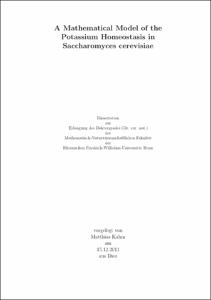Kahm, Matthias: A Mathematical Model of the Potassium Homeostasis in Saccharomyces cerevisiae. - Bonn, 2012. - Dissertation, Rheinische Friedrich-Wilhelms-Universität Bonn.
Online-Ausgabe in bonndoc: https://nbn-resolving.org/urn:nbn:de:hbz:5n-29034
Online-Ausgabe in bonndoc: https://nbn-resolving.org/urn:nbn:de:hbz:5n-29034
@phdthesis{handle:20.500.11811/5332,
urn: https://nbn-resolving.org/urn:nbn:de:hbz:5n-29034,
author = {{Matthias Kahm}},
title = {A Mathematical Model of the Potassium Homeostasis in Saccharomyces cerevisiae},
school = {Rheinische Friedrich-Wilhelms-Universität Bonn},
year = 2012,
month = jul,
note = {Without potassium, all living cells will die; it has to be present in sufficient amounts for the proper function of most cell types. Disturbances in potassium levels in animal cells result in potentially fatal conditions and it is also an essential nutrient for plants and fungi. Cells have developed effective mechanisms for surviving under adverse environmental conditions of low external potassium. The question is how. Using the eukaryotic model organism, baker's yeast Saccharomyces cerevisiae, we modeled how potassium homeostasis takes place. This is because, through mathematical modeling and experimentation, we found that the electro-chemical forces regulating potassium concentrations are coupled to proton fluxes, which respond to external conditions in order to maintain a viable potassium level within the cells. Our results challenge the current understanding of potassium homeostasis in baker's yeast, and could potentially be extended to other microorganisms, including non-conventional yeasts such as the pathogenic Candida albicans, and plant cells. In the future, the fundamental bases for this descriptive and predictive model might contribute to the development of new treatments for fungal infections, or developments in crop sciences.},
url = {https://hdl.handle.net/20.500.11811/5332}
}
urn: https://nbn-resolving.org/urn:nbn:de:hbz:5n-29034,
author = {{Matthias Kahm}},
title = {A Mathematical Model of the Potassium Homeostasis in Saccharomyces cerevisiae},
school = {Rheinische Friedrich-Wilhelms-Universität Bonn},
year = 2012,
month = jul,
note = {Without potassium, all living cells will die; it has to be present in sufficient amounts for the proper function of most cell types. Disturbances in potassium levels in animal cells result in potentially fatal conditions and it is also an essential nutrient for plants and fungi. Cells have developed effective mechanisms for surviving under adverse environmental conditions of low external potassium. The question is how. Using the eukaryotic model organism, baker's yeast Saccharomyces cerevisiae, we modeled how potassium homeostasis takes place. This is because, through mathematical modeling and experimentation, we found that the electro-chemical forces regulating potassium concentrations are coupled to proton fluxes, which respond to external conditions in order to maintain a viable potassium level within the cells. Our results challenge the current understanding of potassium homeostasis in baker's yeast, and could potentially be extended to other microorganisms, including non-conventional yeasts such as the pathogenic Candida albicans, and plant cells. In the future, the fundamental bases for this descriptive and predictive model might contribute to the development of new treatments for fungal infections, or developments in crop sciences.},
url = {https://hdl.handle.net/20.500.11811/5332}
}






